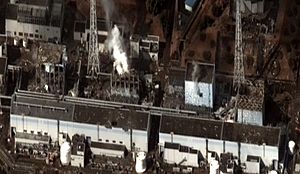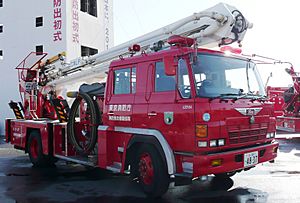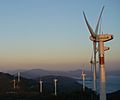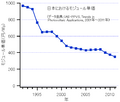Fukushima nuclear disaster facts for kids
The Fukushima nuclear disaster was a serious accident at the Fukushima Daiichi Nuclear Power Plant in Japan. It happened on March 11, 2011, after a huge earthquake and tsunami hit the coast. This event caused equipment to fail, nuclear reactors to melt down, and dangerous radioactive materials to be released.
The power plant had six separate Nuclear reactors. The company that ran it was called the Tokyo Electric Power Company (TEPCO). This disaster is considered the second-largest nuclear accident in history, after the 1986 Chernobyl disaster. However, Fukushima was more complex because many reactors were affected.
Contents
What Caused the Disaster?
When the earthquake hit, reactors 4, 5, and 6 were already shut down for maintenance. The other reactors (1, 2, and 3) turned off automatically, as they were designed to do. But then, a massive tsunami followed the earthquake. The tsunami flooded the entire plant.
The flood damaged important equipment. This included generators and electrical systems in the reactor buildings. Pumps that supplied cooling seawater also stopped working. Because of this, the plant lost all its power. Without power, the cooling systems for the reactors failed. This caused the reactors to start getting too hot.
Reactor Damage and Explosions
Reactors 1, 2, and 3 had partial core meltdowns. This means their nuclear fuel got so hot it melted. Hydrogen explosions then destroyed the upper parts of the buildings for reactors 1, 3, and 4. Reactor 2 also had an explosion that damaged its inner safety structure. Fires broke out at reactor 4.
Even though reactors 5 and 6 were initially shut down, they also began to overheat. Inside each reactor building, used nuclear fuel rods were stored in special pools. As the water levels in these pools dropped, the spent fuel rods also started to overheat.
Immediate Dangers and Evacuation
People were very worried about radiation leaking from the plant. Because of this, everyone living within 20 kilometers (about 12 miles) of the plant had to leave their homes. This was a safety measure to protect them from radiation.
Workers at the plant were also exposed to radiation. They had to be moved out of the area at different times for their safety. On March 20, some power was brought back to parts of the plant. However, the machinery for reactors 1 through 4 was still broken. It had been damaged by the floods, fires, and explosions.
Ongoing Challenges and Contamination
Radioactive water continued to flood the basements of units 1 to 4. This made it very hard for workers to get in and fix things. Measurements taken in northern Japan, about 30-50 kilometers from the plant, showed high levels of radioactive caesium. This was a serious concern.
Food grown in the affected area was banned from being sold. Experts suggested that the amount of iodine-131 and caesium-137 released from Fukushima was similar to what was released during the Chernobyl disaster.
Officials in Tokyo even advised that tap water should not be used to prepare food for children. Plutonium, another dangerous radioactive material, was found in the soil at two spots within the plant. Some workers were exposed to high levels of radiation at their ankles when standing in water inside unit 3. Radiation levels changed a lot depending on the time and location.
Impact on Nuclear Power
The nuclear emergencies at Fukushima raised big questions about the future of nuclear power around the world. An energy news website called Platts said that the crisis made many countries review the safety of their nuclear reactors. It also made them rethink plans to build more nuclear power plants.
After the Fukushima disaster, the International Energy Agency cut its prediction for how much new nuclear power would be built by 2035. They expected much less new nuclear capacity than before.
Related pages
Images for kids
-
Cross-section of a typical BWR Mark I containment as used in units 1 to 5. RPV: reactor pressure vessel DW: drywell enclosing reactor pressure vessel. WW: wetwell – torus-shaped all around the base enclosing steam suppression pool. Excess steam from the drywell enters the wetwell water pool via downcomer pipes. SFP: spent fuel pool area SCSW: secondary concrete shield wall
-
Unit 4 after the hydrogen explosion. The bright yellow object is the reactor's removed Primary Containment Vessel head or drywell lid. The removed large black Reactor Pressure Vessel head with its lifting frame attached is to the left. Both had been removed to allow refueling at the time. The green object is the crane for the spent fuel pool.
-
The town of Namie (population 21,000) was evacuated as a result of the disaster
-
IAEA team examining Unit 3
-
Protest against nuclear power in Berlin, Germany, March 2011
-
Part of the Seto Hill Windfarm in Japan, one of several windfarms that continued generating without interruption after the 2011 earthquake and tsunami and the Fukushima nuclear disaster
-
Anti-nuclear power plant rally on 19 September 2011 at the Meiji Shrine complex in Tokyo
-
Japan towns, villages, and cities in and around the Daiichi nuclear plant exclusion zone. The 20 and 30 km (12 and 19 mi) areas had evacuation and shelter in place orders, and additional administrative districts that had an evacuation order are highlighted. However, the above map's factual accuracy is called into question as only the southern portion of Kawamata district had evacuation orders. More accurate maps are available.
-
IAEA experts at Unit 4, 2013
-
Protest against nuclear power in Cologne, Germany on 26 March 2011
See also
 In Spanish: Accidente nuclear de Fukushima I para niños
In Spanish: Accidente nuclear de Fukushima I para niños























